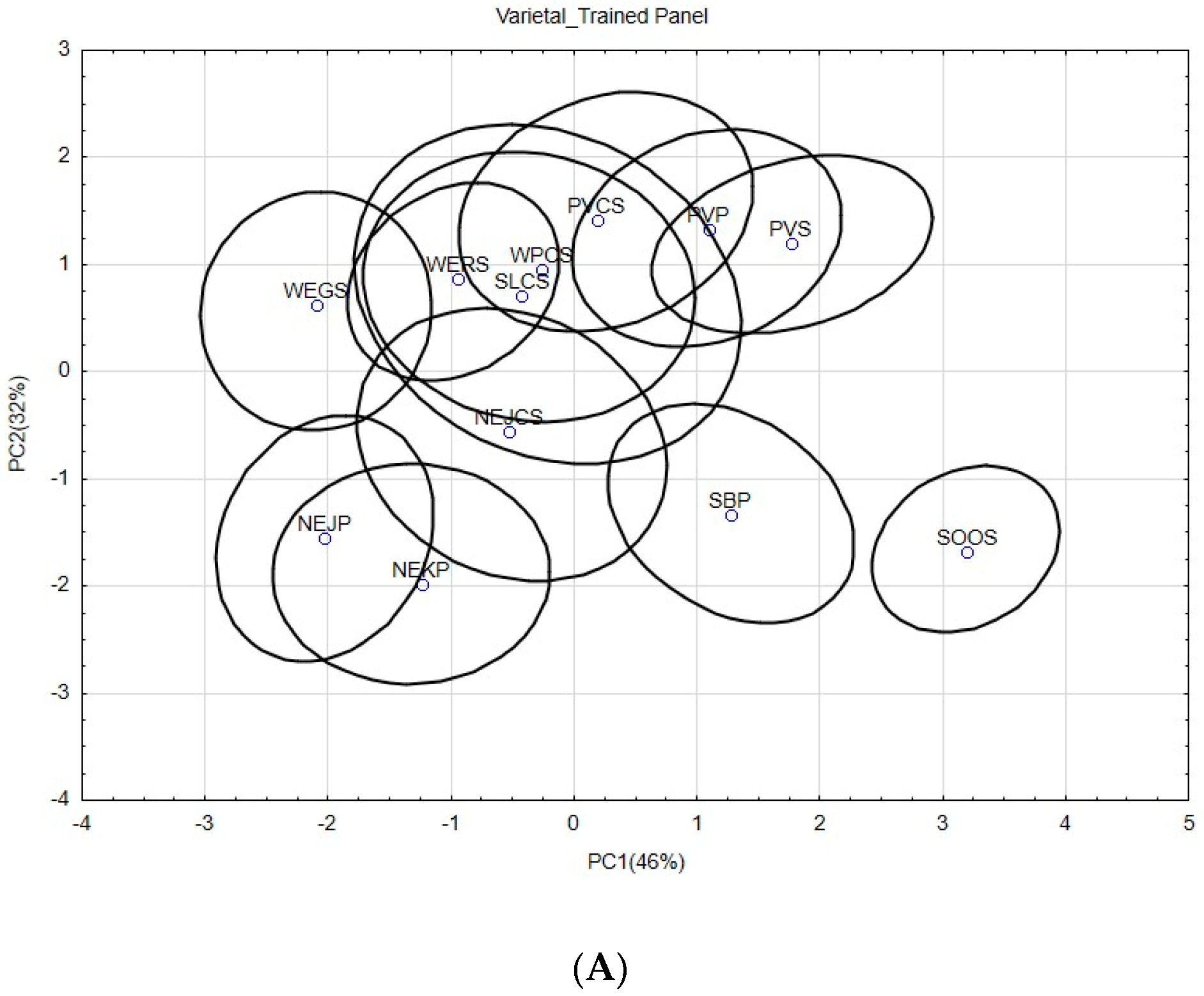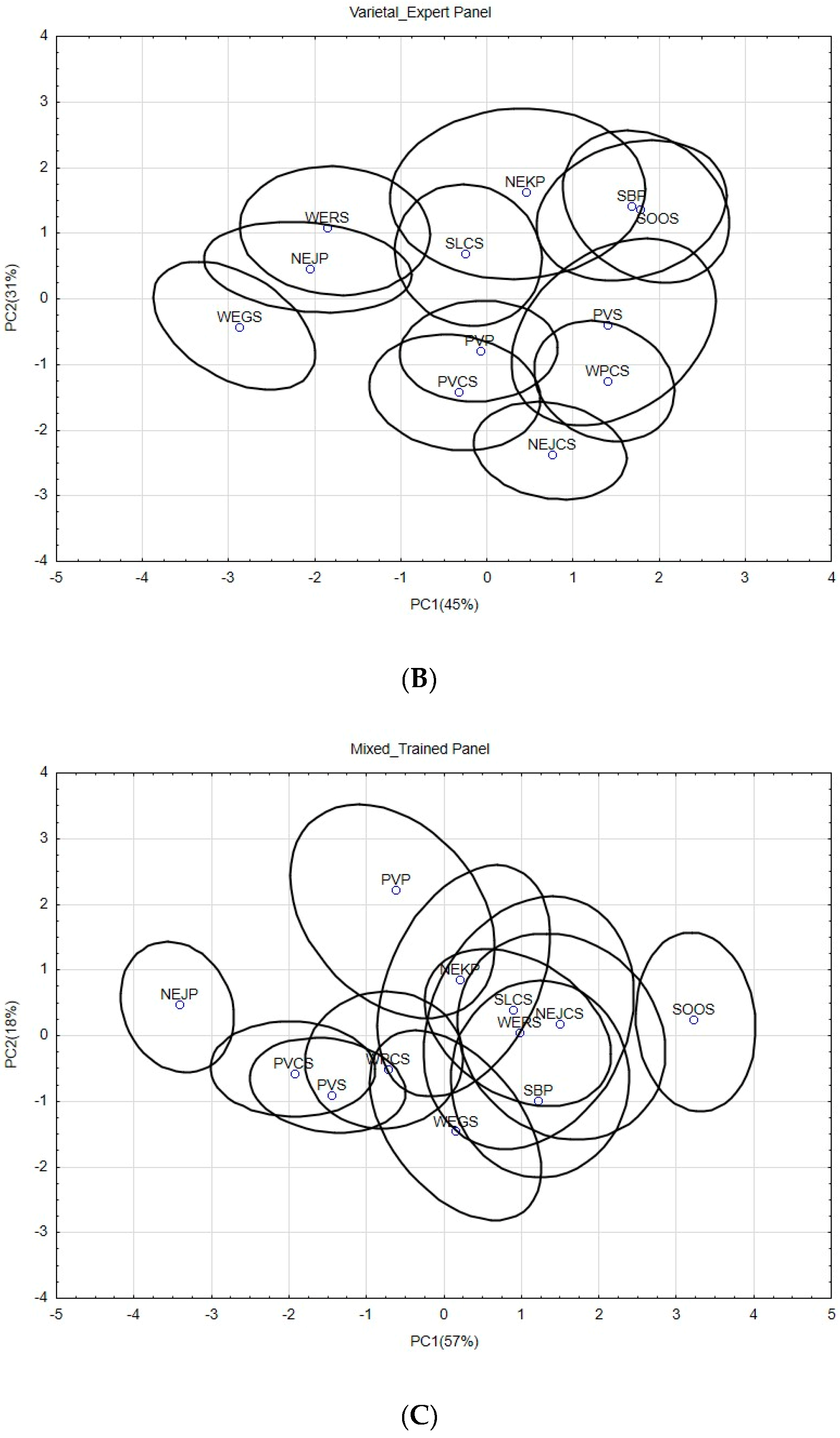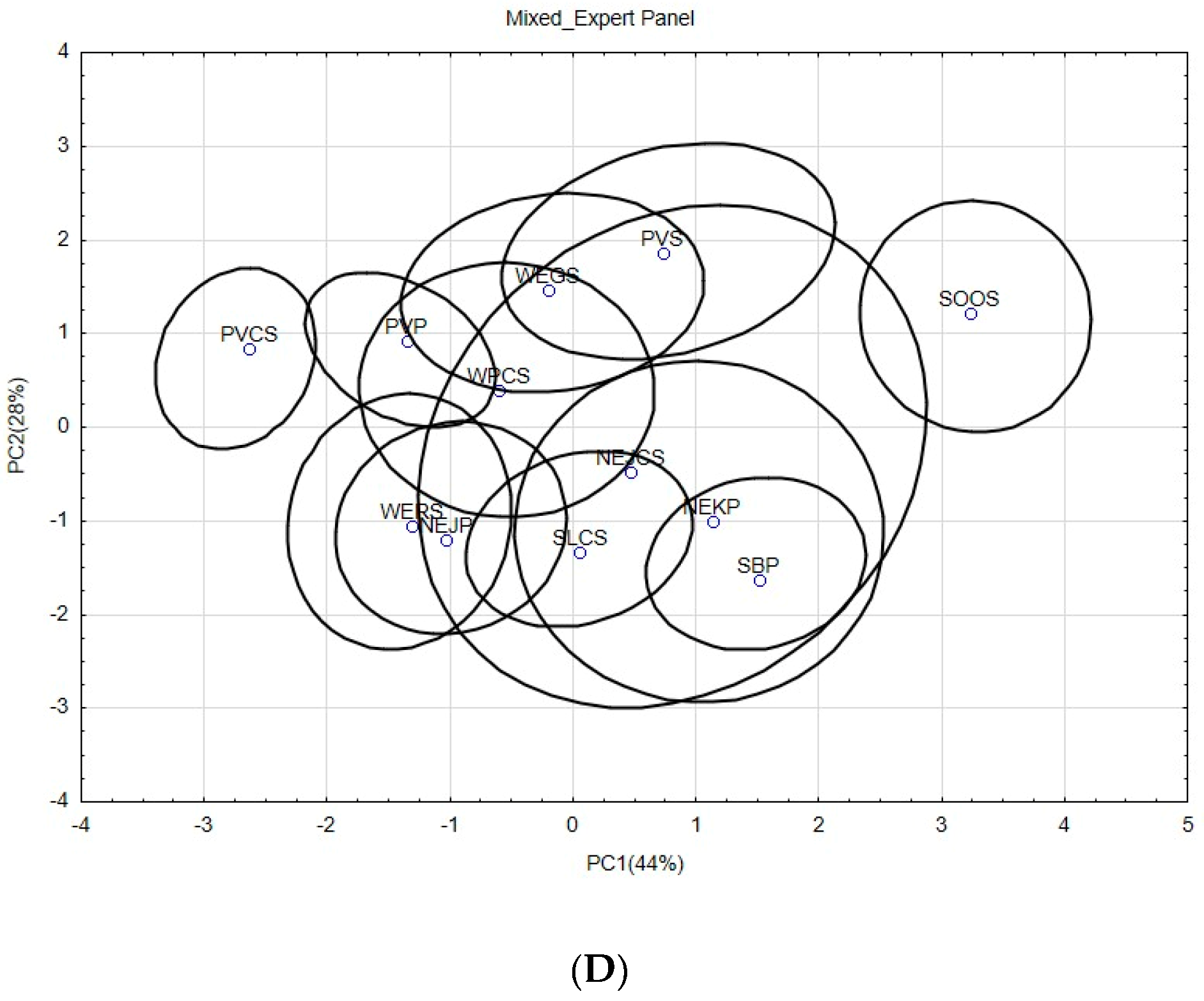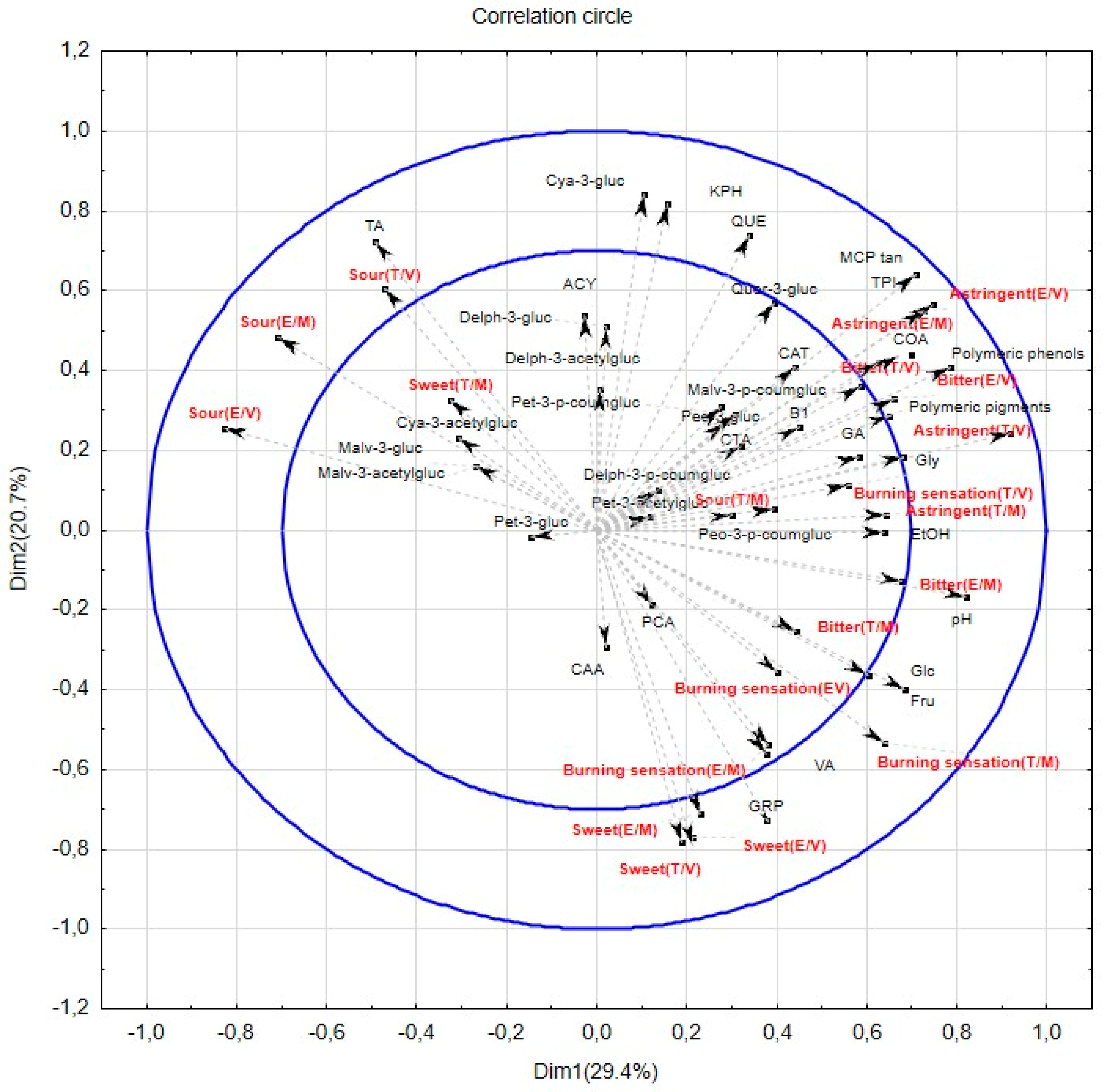Basic In-Mouth Attribute Evaluation: A Comparison of Two Panels
Abstract
1. Introduction
2. Materials and Methods
2.1. Chemicals and Standards
2.2. Wine Samples
2.3. Wine Characterization
2.4. Sensory Evaluation
2.4.1. Trained Panel (T)
2.4.2. Expert Panel (E)
2.4.3. Formal Tastings
2.5. Statistical Procedures
3. Results and Discussion
4. Conclusions
Supplementary Materials
Author Contributions
Funding
Acknowledgments
Conflicts of Interest
References
- Charters, S.; Pettigrew, S. The dimensions of wine quality. Food Qual. Prefer. 2007, 18, 997–1007. [Google Scholar] [CrossRef]
- Monteleone, E.; Dinnella, C.; Condelli, N. Perceived astringency in wine: A predictive model. Acta Hortic. 2007, 754, 523–532. [Google Scholar] [CrossRef]
- Peynaud, E. The Taste of Wine: The Art and Science of Wine Appreciation; Macdonald & Co.: London, UK, 1987. [Google Scholar]
- Sáenz-Navajas, M.-P.; Ballester, J.; Pêcher, C.; Peyron, D.; Valentin, D. Sensory drivers of intrinsic quality of red wines. Food Res. Int. 2013, 54, 1506–1518. [Google Scholar] [CrossRef]
- ASTM Standard definitions of terms relating to sensory evaluation of materials and products. In Annual Book of ASTM Standards; American Society for Testing and Materials: Philadelphia, PA, USA, 2004.
- Gawel, R.; Oberholster, A.; Francis, I.L. A ‘Mouth-feel Wheel’: Terminology for communicating the mouth-feel characteristics of red wine. Aust. J. Grape Wine Res. 2000, 6, 203–207. [Google Scholar] [CrossRef]
- Chira, K.; Jourdes, M.; Teissedre, P.L. Cabernet sauvignon red wine astringency quality control by tannin characterization and polymerization during storage. Eur. Food Res. Technol. 2012, 234, 253–261. [Google Scholar] [CrossRef]
- Ma, W.; Guo, A.; Zhang, Y.; Wang, H.; Liu, Y.; Li, H. A review on astringency and bitterness perception of tannins in wine. Trends Food Sci. Technol. 2014, 40, 6–19. [Google Scholar] [CrossRef]
- Kallithraka, S.; Kotseridis, Y.; Kyraleou, M.; Proxenia, N.; Tsakiris, A.; Karapetrou, G. Analytical phenolic composition and sensory assessment of selected rare Greek cultivars after extended bottle ageing. J. Sci. Food Agric. 2015, 95, 1638–1647. [Google Scholar] [CrossRef]
- Landon, J.L.; Weller, K.; Harbertson, J.F.; Ross, C.F. Chemical and sensory evaluation of astringency in Washington State red wines. Am. J. Enol. Vitic. 2008, 59, 153–158. [Google Scholar]
- Quijada-Morín, N.; Regueiro, J.; Simal-Gándara, J.; Tomás, E.; Rivas-Gonzalo, J.C.; Escribano-Bailón, M.T. Relationship between the sensory-determined astringency and the flavanolic composition of red wines. J. Agric. Food Chem. 2012, 60, 12355–12361. [Google Scholar] [CrossRef]
- Robichaud, J.L.; Noble, A.C. Astringency and bitterness of selected phenolics in wine. J. Sci. Food Agric. 1990, 53, 343–353. [Google Scholar] [CrossRef]
- Troszyñska, A.; Lamparski, G.; Kmita-Głażewska, H. Evaluation of astringency of preparations with different degree of tannin polymerisation. Pol. J. Food Nutr. Sci. 2003, 12, 84–86. [Google Scholar]
- McRae, J.M.; Ziora, Z.M.; Kassara, S.; Cooper, M.A.; Smith, P.A. Ethanol Concentration Influences the Mechanisms of Wine Tannin Interactions with Poly(L-proline) in Model Wine. J. Agric. Food Chem. 2015, 63, 4345–4352. [Google Scholar] [CrossRef] [PubMed]
- Vidal, S.; Courcoux, P.; Francis, L.; Kwiatkowski, M.; Gawel, R.; Williams, P.; Waters, E.; Cheynier, V. Use of an experimental design approach for evaluation of key wine components on mouth-feel perception. Food Qual. Prefer. 2004, 15, 209–217. [Google Scholar] [CrossRef]
- Herderich, M.J.; Smith, P. Analysis of grape and wine tannins: Methods, applications and challenges. Aust. J. Grape Wine Res. 2005, 11, 205–214. [Google Scholar] [CrossRef]
- Hagerman, A.E.; Butler, L.G. Protein precipitation method for the quantitative determination of tannins. J. Agric. Food Chem. 1978, 26, 809–812. [Google Scholar] [CrossRef]
- Saeneckis, C.J.; Damberga, R.G.; Jones, P.; Mercurio, M.; Herderich, M.J.; Smith, P.A. Quantification of condensed tannins by precipitation with methyl cellulose: Development and validation of an optimised tool for grape and wine analysis. Aust. J. Grape Wine Res. 2006, 12, 39–49. [Google Scholar] [CrossRef]
- Aleixandre-Tudo, J.L.; Buica, A.; Nieuwoudt, H.; Aleixandre, J.L.; du Toit, W. Spectrophotometric Analysis of Phenolic Compounds in Grapes and Wines. J. Agric. Food Chem. 2017, 65, 4009–4026. [Google Scholar] [CrossRef]
- Kyraleou, M.; Kotseridis, Y.; Koundouras, S.; Chira, K.; Teissedre, P.L.; Kallithraka, S. Effect of irrigation regime on perceived astringency and proanthocyanidin composition of skins and seeds of Vitis vinifera L. cv. Syrah grapes under semiarid conditions. Food Chem. 2016, 203, 292–300. [Google Scholar] [CrossRef]
- Mercurio, M.D.; Smith, P. Tannin quantification in red grapes and wine: Comparison of polysaccharide- and protein-based tannin precipitation techniques and their ability to model wine astringency. J. Agric. Food Chem. 2008, 56, 5528–5537. [Google Scholar] [CrossRef]
- Mercurio, M.D.; Dambergs, R.G.; Cozzolino, D.; Herderich, M.J.; Smith, P. Relationship between red wine grades and phenolics. 1. Tannin and total phenolics concentrations. J. Agric. Food Chem. 2010, 58, 12313–12319. [Google Scholar] [CrossRef]
- Aleixandre-Tudo, J.L.; Nieuwoudt, H.; Aleixandre, J.L.; Du Toit, W.J. Robust Ultraviolet–Visible (UV–Vis) Partial Least-Squares (PLS) Models for Tannin Quantification in Red Wine. J. Agric. Food Chem. 2015, 63, 1088–1098. [Google Scholar] [CrossRef] [PubMed]
- Daniel, C. The role of visible and infrared spectroscopy combined with chemometrics to measure phenolic compounds in grape and wine samples. Molecules 2015, 20, 726–737. [Google Scholar] [CrossRef]
- Dambergs, R.; Gishen, M.; Cozzolino, D. A Review of the State of the Art, Limitations, and Perspectives of Infrared Spectroscopy for the Analysis of Wine Grapes, Must, and Grapevine Tissue. Appl. Spectrosc. Rev. 2015, 50, 261–278. [Google Scholar] [CrossRef]
- Lee, C.B.; Lawless, H.T. Time-course of astringent materials. Chem. Senses 1991, 16, 225–238. [Google Scholar] [CrossRef]
- Ashton, R.H. Dimensions of Expertise in Wine Evaluation. J. Wine Econ. 2016. [Google Scholar] [CrossRef]
- Peleg, H.; Gacon, K.; Schlich, P.; Noble, A.C. Bitterness and astringency of flavan-3-ol monomers, dimers and trimers. J. Sci. Food Agric. 1999, 79, 1123–1128. [Google Scholar] [CrossRef]
- Lawless, H.T.; Heymann, H. Sensory Evaluation of Food: Principles and Practices; Aspen Publishers: Gaithersburg, MD, USA, 1998. [Google Scholar]
- Arvisenet, G.; Guichard, E.; Ballester, J. Taste-aroma interaction in model wines: Effect of training and expertise. Food Qual. Prefer. 2016, 52, 211–221. [Google Scholar] [CrossRef]
- Gawel, R. The use of language by trained and untrained experienced wine tasters. J. Sens. Stud. 1997, 12, 267–284. [Google Scholar] [CrossRef]
- Sauvageot, F.; Urdapilleta, I.; Peyron, D. Within and between variations of texts elicited from nine wine experts. Food Qual. Prefer. 2006, 17, 429–444. [Google Scholar] [CrossRef]
- Solomon, G. Psychology of novice and expert wine talk. Am. J. Psychol. 1990, 103, 495–517. [Google Scholar] [CrossRef]
- Ballester, J.; Mihnea, M.; Peyron, D.; Valentin, D. Exploring minerality of Burgundy Chardonnay wines: A sensory approach with wine experts and trained panellists. Aust. J. Grape Wine Res. 2013, 19. [Google Scholar] [CrossRef]
- Hopfer, H.; Heymann, H. Judging wine quality: Do we need experts, consumers or trained panelists? Food Qual. Prefer. 2014, 32, 221–233. [Google Scholar] [CrossRef]
- Parr, W.V.; White, K.G.; Heatherbell, D. Exploring the nature of wine expertise: What underlies wine experts’ olfactory recognition memory advantage? Food Qual. Prefer. 2004, 15, 411–420. [Google Scholar] [CrossRef]
- Sáenz-Navajas, M.-P.; Campo, E.; Sutan, A.; Ballester, J.; Valentin, D. Perception of wine quality according to extrinsic cues: The case of Burgundy wine consumers. Food Qual. Prefer. 2013, 27, 44–53. [Google Scholar] [CrossRef]
- Torri, L.; Dinnella, C.; Recchia, A.; Naes, T.; Tuorila, H.; Monteleone, E. Projective Mapping for interpreting wine aroma differences as perceived by naive and experienced assessors. Food Qual. Prefer. 2013, 29, 6–15. [Google Scholar] [CrossRef]
- Nieuwoudt, H.H.; Prior, B.A.; Pretorius, I.S.; Manley, M.; Bauer, F.F. Principal Component Analysis Applied to Fourier Transform Glycerol Prediction Models in Wine and for the Detection and Classification of Outlier Samples. J. Agric. Food Chem. 2004, 52, 3726–3735. [Google Scholar] [CrossRef]
- Peng, Z.; Iland, P.G.; Oberholster, A.; Sefton, M.A.; Waters, E.J. Analysis of pigmented polymers in red wine by reverse phase HPLC. Aust. J. Grape Wine Res. 2002, 8, 70–75. [Google Scholar] [CrossRef]
- ISO. Sensory Analysis: Apparatus Wine Tasting Glass; ISO: Geneva, Switzerland, 1977. [Google Scholar]
- Colonna, A. Comparison of procedures for reducing astringency carry-over effects in evaluation of red wines. J. Grape Wine 2004, 10, 26–31. [Google Scholar] [CrossRef]
- Escoufier, Y. Le Traitement des Variables Vectorielles. Biometrics 1973, 29, 751–760. [Google Scholar] [CrossRef]
- Abdi, H.; Valentin, D.; Chollet, S.; Chrea, C. Analyzing assessors and products in sorting tasks: Distatis, theory and applications. Food Qual. Prefer. 2007, 18, 627–640. [Google Scholar] [CrossRef]
- Canul, L.G.R.; Rivera, E.D.; Cabrera, R.S.; Delgado Vidal, F.K.; Juárez Barrientos, J.M.; Hernández Cervantes, M.; López Velázquez, J.; Gómez Alvarado, T. Performance Comparison among Trained Judges and Panels for the Evaluation of “Cuajada” Type Fresh Cheese in Two Regions from Oaxaca in México. Food Nutr. Sci. 2011, 2, 1166–1179. [Google Scholar] [CrossRef]
- Zamora, M.C.; Guirao, M. Performance comparison between trained assessors and wine experts using specific sensory attributes. J. Sens. Stud. 2004, 19, 530–545. [Google Scholar] [CrossRef]
- Condelli, N.; Dinnella, C.; Cerone, A.; Monteleone, E.; Bertuccioli, M. Prediction of perceived astringency induced by phenolic compounds II: Criteria for panel selection and preliminary application on wine samples. Food Qual. Prefer. 2006, 17, 96–107. [Google Scholar] [CrossRef]
- Dambergs, R.G.; Mercurio, M.D.; Kassara, S.; Cozzolino, D.; Smith, P.A. Rapid measurement of methyl cellulose precipitable tannins using ultraviolet spectroscopy with chemometrics: Application to red wine and inter-laboratory calibration transfer. Appl. Spectrosc. 2012, 66, 656–664. [Google Scholar] [CrossRef] [PubMed]




| Wine | Variety | pH | VA a | TA b | Ethanol (v/v %) | MCP tan c | ACY d | TPI e | Glucose (g/L) | Fructose (g/L) | Glycerol (g/L) |
|---|---|---|---|---|---|---|---|---|---|---|---|
| NEJCS f | Cabernet Sauvignon | 3.6 | 0.50 | 6.2 | 14.86 | 2118 | 487.8 | 73.59 | 0.39 | 1.22 | 12.41 |
| PVCS | Cabernet Sauvignon | 3.6 | 0.43 | 6.2 | 14.73 | 1389 | 447.0 | 54.67 | n.d. | 1.15 | 10.81 |
| SLCS | Cabernet Sauvignon | 3.8 | 0.47 | 5.8 | 14.95 | 1541 | 425.2 | 58.35 | 0.03 | 2.58 | 11.85 |
| WPCS | Cabernet Sauvignon | 3.7 | 0.57 | 6.0 | 14.79 | 2297 | 523.7 | 72.36 | n.d. g | 1.51 | 11.96 |
| NEJP | Pinotage | 3.5 | 0.64 | 5.8 | 14.33 | 896.9 | 462.5 | 47.66 | 0.78 | 1.33 | 11.25 |
| NEKP | Pinotage | 3.6 | 0.87 | 5.9 | 14.95 | 967.3 | 481.8 | 49.06 | 0.81 | 1.81 | 11.29 |
| PVP | Pinotage | 3.5 | 0.56 | 6.2 | 14.36 | 2045 | 776.6 | 78.86 | 0.54 | 1.28 | 10.93 |
| SBP | Pinotage | 3.7 | 0.73 | 5.6 | 14.77 | 1716 | 569.8 | 63.99 | 0.86 | 1.48 | 11.07 |
| PVS | Shiraz | 3.6 | 0.73 | 6.1 | 15.08 | 2567 | 640.5 | 84.64 | 0.87 | 1.25 | 11.26 |
| SOOS | Shiraz | 4.0 | 0.72 | 5.4 | 15.04 | 2485 | 631.0 | 83.73 | 1.08 | 3.30 | 11.89 |
| WEGS | Shiraz | 3.5 | 0.58 | 6.0 | 13.17 | 285.1 | 514.3 | 38.68 | 0.03 | 0.97 | 10.64 |
| WERS | Shiraz | 3.6 | 0.64 | 5.8 | 14.76 | 622.8 | 700.6 | 51.04 | 0.27 | 1.24 | 10.81 |
| Panel | Attribute | ICC (Agreement) | ICC (Consistency) | Correlation | p-Value | SEM |
|---|---|---|---|---|---|---|
| T | Sweet | 0.105 | 0.097 | −0.120 | 0.700 | 0.430 |
| Sour | −0.055 | −0.051 | 0.020 | 0.950 | 0.788 | |
| Bitter | 0.116 | 0.109 | 0.400 | 0.200 | 0.844 | |
| Astringent | 0.733 | 0.718 | 0.720 | 0.010 | 0.636 | |
| Burning sensation | 0.127 | 0.118 | 0.120 | 0.720 | 0.631 | |
| E | Sweet | 0.201 | 0.188 | 0.200 | 0.540 | 0.662 |
| Sour | 0.279 | 0.262 | 0.720 | 0.010 | 0.763 | |
| Bitter | 0.302 | 0.287 | 0.540 | 0.070 | 0.600 | |
| Astringent | 0.799 | 0.833 | 0.920 | 0.000 | 0.401 | |
| Burning sensation | 0.558 | 0.556 | 0.550 | 0.060 | 0.433 | |
| T vs. E | Sweet | −0.078 | −0.146 | −0.260 | 0.130 | 0.859 |
| Sour | −0.148 | −0.147 | −0.180 | 0.300 | 0.867 | |
| Bitter | −0.138 | −0.150 | −0.020 | 0.910 | 0.954 | |
| Astringent | 0.608 | 0.601 | 0.670 | 0.000 | 0.710 | |
| Burning sensation | 0.228 | 0.326 | 0.180 | 0.300 | 0.580 |
| Grape Variety | Wine Name | Sweet | Sour | Bitter | Astringent | Burning Sensation | |||||
|---|---|---|---|---|---|---|---|---|---|---|---|
| T a | E b | T | E | T | E | T | E | T | E | ||
| Cabernet Sauvignon | NEJCS e | 1.21 c (1.11 d) | 1.41 (1.20) | 3.64 (1.71) | 3.97 (2.33) | 2.98 (2.01) | 4.69 (1.68) | 6.11 (1.96) | 5.82 (2.16) | 3.26 (1.60) | 3.92 (2.30) |
| PVCS | 1.28 (1.08) | 2.03 (1.70) | 4.34 (1.48) | 4.35 (1.64) | 3.81 (1.98) | 4.20 (1.68) | 4.43 (2.11) | 5.52 (1.73) | 3.71 (1.97) | 3.96 (2.20) | |
| SLCS | 1.53 (1.58) | 2.67 (1.95) | 4.32 (1.97) | 3.29 (1.88) | 3.83 (2.34) | 3.52 (1.61) | 4.81 (2.47) | 5.45 (1.61) | 3.22 (2.50) | 3.83 (1.79) | |
| WPCS | 0.90 (0.68) | 2.07 (1.73) | 3.94 (1.75) | 3.68 (1.63) | 3.44 (2.09) | 4.78 (1.90) | 6.00 (2.02) | 6.20 (1.81) | 3.15 (2.11) | 4.02 (2.39) | |
| Pinotage | NEJP | 1.58 (1.57) | 2.94 (2.18) ** | 3.43 (1.71) | 4.52 (1.85) | 2.96 (2.25) | 3.47 (1.83) | 4.53 (1.93) | 4.45 (1.95) | 2.83 (1.35) | 3.95 (2.23) |
| NEKP | 1.84 (1.87) | 3.02 (1.99) | 3.48 (1.73) | 3.82 (1.90) | 3.09 (1.75) | 3.96 (1.76) | 4.95 (2.09) | 5.11 (1.77) | 3.09 (1.40) | 5.28 (1.85) ** | |
| PVP | 0.98 (1.07) | 2.49 (1.72) * | 4.00 (1.65) | 4.28 (2.18) | 3.90 (2.17) | 4.15 (1.90) | 5.76 (2.16) | 5.93 (1.82) | 3.69 (1.84) | 3.93 (2.00) | |
| SBP | 1.54 (1.90) | 2.83 (1.93) | 3.37 (2.06) | 3.20 (2.11) | 3.52 (2.49) | 4.28 (2.60) | 6.31 (1.89) | 5.71 (1.72) | 3.82 (1.81) | 5.13 (2.24) | |
| Shiraz | PVS | 1.18 (1.14) | 2.08 (1.30) | 4.16 (2.26) | 3.51 (1.99) | 4.17 (2.31) | 3.88 (2.81) | 6.52 (2.02) | 6.76 (2.03) | 3.70 (1.90) | 4.58 (2.06) |
| SOOS | 1.46 (1.61) | 3.31 (2.62) * | 2.90 (1.52) | 2.86 (1.94) | 4.12 (1.93) | 4.65 (2.00) | 7.18 (1.52) | 5.98 (1.56) | 4.14 (1.39) | 4.01 (2.16) | |
| WEGS | 1.06 (0.90) | 2.29 (1.70) ** | 3.86 (2.11) | 4.09 (1.70) | 2.96 (1.98) | 3.15 (1.79) | 3.47 (2.01) | 4.00 (1.94) | 3.16 (1.81) | 3.08 (1.69) | |
| WERS | 1.08 (1.11) | 2.72 (1.53) * | 3.88 (1.30) | 3.81 (1.45) | 3.41 (1.86) | 3.25 (1.48) | 3.90 (1.50) | 3.98 (2.00) | 3.38 (1.68) | 4.11 (1.89) | |
| Wine Set | Wine Name | Sweet | Sour | Bitter | Astringent | Burning Sensation | |||||
|---|---|---|---|---|---|---|---|---|---|---|---|
| T a | E b | T | E | T | E | T | E | T | E | ||
| Set 1 | NEJCS e | 0.97 c (1.28) d | 2.70 (2.04) | 4.65 (1.33) | 3.12 (1.68) | 3.48 (1.67) | 3.86 (1.60) | 7.33 (1.83) | 6.60 (1.70) | 3.68 (1.42) | 3.10 (2.21) |
| NEKP | 1.17 (1.87) | 3.24 (2.54) * | 4.25 (1.35) | 3.26 (1.78) | 3.30 (2.35) | 3.66 (2.02) | 4.70 (1.91) | 5.04 (1.64) | 4.00 (1.52) | 5.06 (2.78) | |
| SBP | 0.65 (0.63) | 3.24 (1.42) * | 3.92 (1.32) | 2.62 (1.78) | 3.60 (2.09) | 3.70 (2.17) | 6.40 (1.60) | 5.54 (2.02) | 3.82 (1.49) | 4.06 (1.59) | |
| SLCS | 1.35 (0.90) | 3.38 (1.790) * | 4.53 (1.27) | 3.46 (1.46) | 3.73 (2.24) | 3.54 (1.81) | 6.45 (1.35) | 5.30 (2.00) | 3.62 (1.32) | 3.82 (1.99) | |
| SOOS | 1.18 (2.04) | 2.36 (2.07) | 4.32 (2.20) | 2.90 (1.20) | 4.45 (2.54) | 5.52 (2.22) | 7.53 (1.67) | 6.26 (1.56) | 4.32 (2.45) | 5.00 (0.46) | |
| WERS | 0.92 (1.63) | 2.44 (1.85) | 4.10 (1.21) | 3.68 (0.97) | 3.97 (2.14) | 3.22 (1.99) | 4.53 (1.77) | 3.68 (1.87) | 3.92 (1.88) | 4.12 (2.49) | |
| Set 2 | NEJP | 2.36 (1.16) | 2.58 (1.97) | 3.50 (2.14) | 3.54 (2.16) | 2.74 (1.93) | 3.64 (1.86) | 3.69 (1.98) | 3.52 (2.01) | 3.49 (1.85) | 3.74 (2.79) |
| PVCS | 1.54 (0.72) | 1.02 (0.41) | 3.70 (1.29) | 4.22 (2.11) | 3.24 (1.88) | 3.30 (2.21) | 4.30 (2.14) | 4.12 (1.71) | 3.26 (2.48) | 3.80 (2.02) | |
| PVP | 1.99 (0.85) | 1.32 (0.73) | 4.86 (1.61) | 3.86 (1.91) | 3.34 (2.55) | 3.26 (2.05) | 4.60 (2.30) | 5.68 (2.55) | 3.66 (1.49) | 3.98 (3.09) | |
| PVS | 1.54 (0.81) | 1.42 (0.73) | 3.59 (2.00) | 3.56 (2.17) | 3.23 (2.32) | 4.50 (2.68) | 5.39 (1.93) | 6.50 (2.60) | 3.37 (1.72) | 4.38 (3.49) | |
| WEGS | 1.19 (0.84) | 1.62 (1.04) | 3.79 (1.94) | 3.88 (2.30) | 3.89 (3.16) | 4.20 (2.68) | 6.31 (2.19) | 6.00 (2.83) | 3.31 (2.12) | 4.16 (2.98) | |
| WPCS | 1.67 (1.00) | 2.02 (2.63) | 3.66 (1.76) | 3.66 (1.83) | 3.30 (2.91) | 3.58 (1.81) | 6.13 (1.55) | 6.18 (2.56) | 3.66 (1.87) | 3.58 (2.45) | |
© 2018 by the authors. Licensee MDPI, Basel, Switzerland. This article is an open access article distributed under the terms and conditions of the Creative Commons Attribution (CC BY) license (http://creativecommons.org/licenses/by/4.0/).
Share and Cite
Mihnea, M.; Aleixandre-Tudó, J.L.; Kidd, M.; du Toit, W. Basic In-Mouth Attribute Evaluation: A Comparison of Two Panels. Foods 2019, 8, 3. https://doi.org/10.3390/foods8010003
Mihnea M, Aleixandre-Tudó JL, Kidd M, du Toit W. Basic In-Mouth Attribute Evaluation: A Comparison of Two Panels. Foods. 2019; 8(1):3. https://doi.org/10.3390/foods8010003
Chicago/Turabian StyleMihnea, Mihaela, José Luis Aleixandre-Tudó, Martin Kidd, and Wessel du Toit. 2019. "Basic In-Mouth Attribute Evaluation: A Comparison of Two Panels" Foods 8, no. 1: 3. https://doi.org/10.3390/foods8010003
APA StyleMihnea, M., Aleixandre-Tudó, J. L., Kidd, M., & du Toit, W. (2019). Basic In-Mouth Attribute Evaluation: A Comparison of Two Panels. Foods, 8(1), 3. https://doi.org/10.3390/foods8010003







